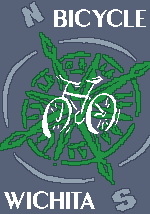Via Kansas Cyclist comes a news story from Ft. Collins about bike-friendly traffic signals: metal-sensing devices in the pavement that can detect the smaller quantities of metal in bikes as they approach intersections, thus changing the lights more quickly.
Sort of off-topic re cycling but still having to do with traffic lights: from 1985-1987 I lived and taught English in Durango, Mexico. There, traffic signals' green lights would flash for a couple of seconds before turning yellow and then red. All other cautions about driving in Mexico notwithstanding, I (a motorist myself while I lived there) always thought that cities in the States would do well to have such a sequencing--how many of us, after all, have found ourselves approaching an intersection and been caught in that awkward place where the light turns yellow and we have to decide whether to slam on the brakes or speed through the intersection? That extra warning of the flashing green, I'd think, would make intersections safer for all concerned--cyclists, too.
All this reminds me as well of Wichita drivers' propensity to not signal lane changes or turns at intersections, but that's a whole other post.
Wednesday, September 17, 2008
Subscribe to:
Post Comments (Atom)















4 comments:
The "stale" green light is responsible for as many intersection collisions as anything else. The flashing green is a good idea.
Cheers.
Actuating signals was a huge hassle in California. The Huntington Beach traffic department starting putting in "bike buttons" (like the pedestrian buttons) on the stanchions at intersections, and I had a huge argument with the traffic engineer about it and told him I would scootch over to the curb and push a button to change a light when car drivers had to get out of their vehicle and do the same thing.
Some of those buttons were at intersections with right-turn-only lanes, so if you were going straight you were literally 20 feet away from the button!
This has been a huge ongoing discussion on internet bike boards. It's the 21st century, we should all be going to video-actuated siganals.
I thought about this a few days ago when I was trying to cross into eastborough at around 12:30 am.That stoplight just west of eastborough wont recognize a bike. I was there for literally 15 minutes waiting for a light change. It only came when a car came through.
The city really should add that to the "this intersection sucks for bikers" list. Not that the city cares about cyclists.
Thanks for the comments.
Coppercorn, I see now that my description wasn't very clear, and I've gone back and tried to clear it up. These sensors are actually in the pavement at intersections; they're sensitive enough to detect the smaller amount of metal in bikes. Moreover, these sensors cost about $400/intersection, as opposed to about $1200/intersection for video monitors.
Chris, the same is true of an intersection on my commute: Pawnee and George Washington. Compounding the potential for delay is that GW has protected left turns, and when a car is in that lane, the sensor doesn't trigger a green light for through-traffic--just for the left turn. I forgot this fact just this morning: a car was in the left turn lane to turn east on Pawnee; I saw the Pawnee lights turn yellow and anticipated my light's turning green by getting an early start heading south on GW (no cars were approaching on Pawnee); and I was in the intersection when I saw that the light for through traffic didn't turn green, and the protected left turn arrow was already turning yellow. So, I ended up running through a red light. Aarrgghh.
Post a Comment